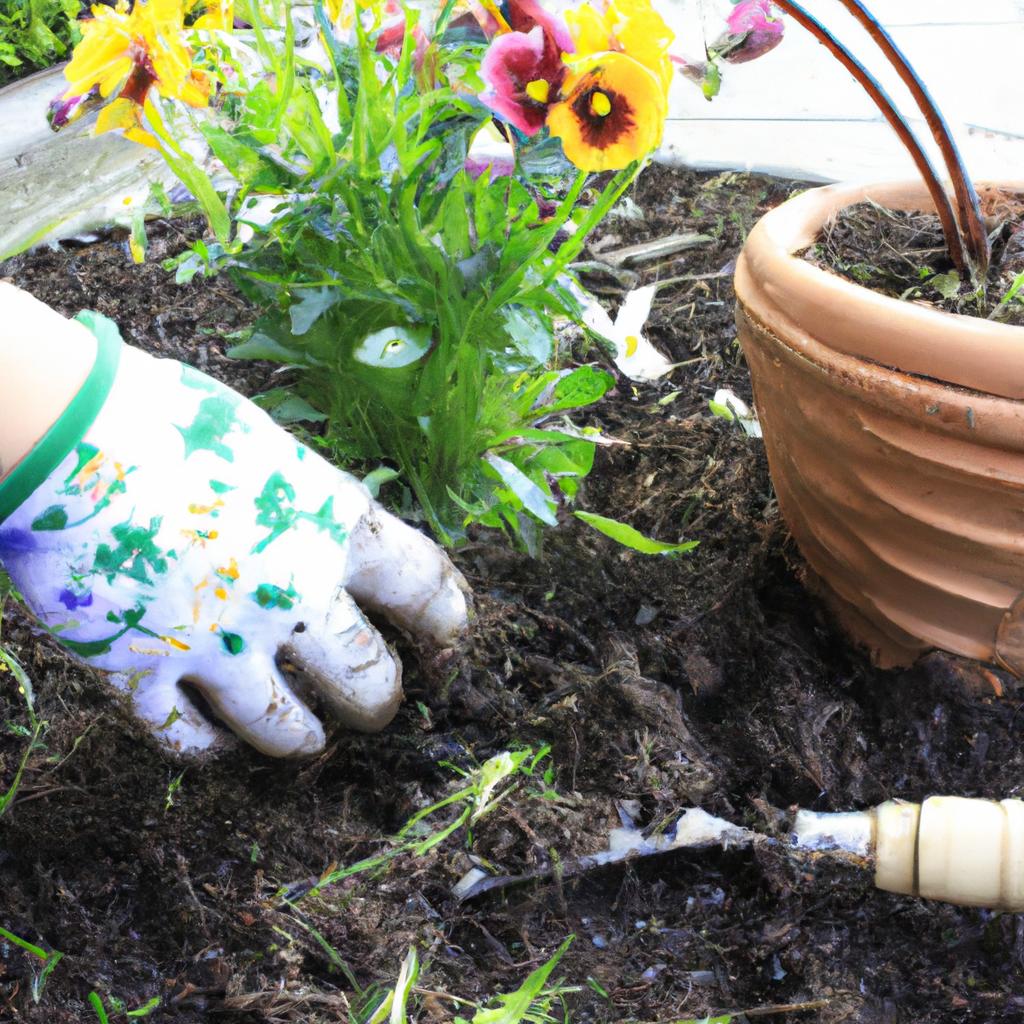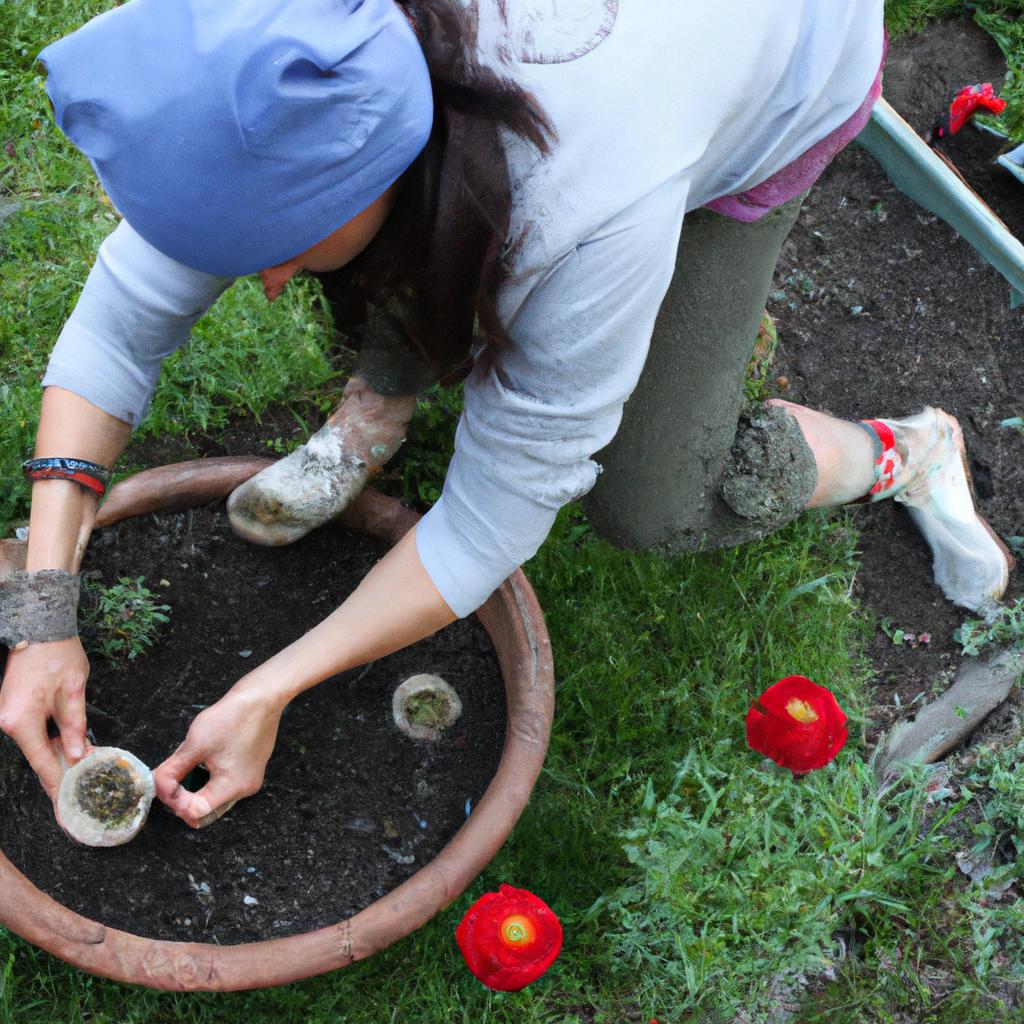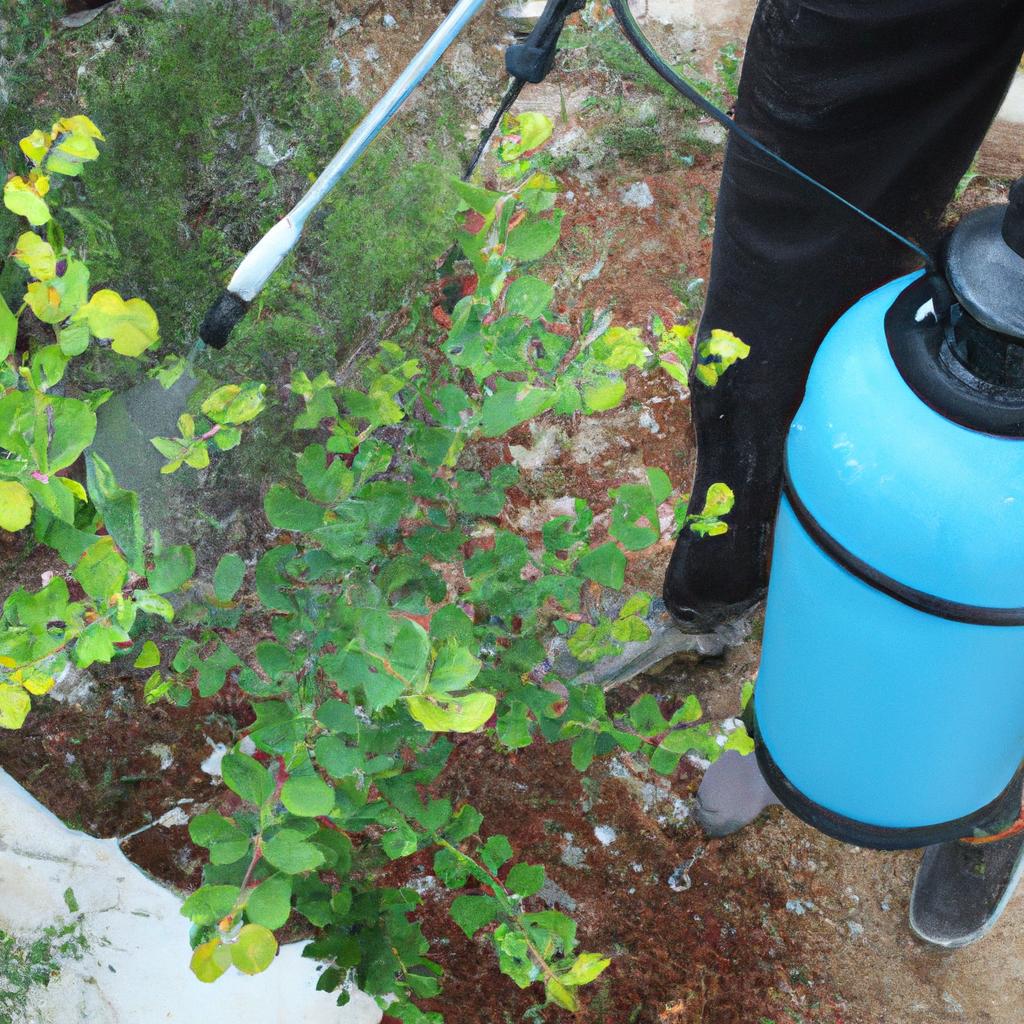In recent years, there has been a growing interest in organic gardening techniques as individuals and communities become more conscious of their impact on the environment. This shift towards sustainable practices extends beyond personal gardens and is now being adopted by various industries, including the hospitality sector. One such example is the family-run guesthouse located in a picturesque countryside setting, which has embraced organic gardening to enhance both the aesthetics of its surroundings and the quality of its offerings.
A hypothetical scenario can help illustrate the benefits of introducing organic gardening at this family-run guesthouse. Imagine a group of guests arriving at the guesthouse for a weekend getaway. As they step out onto the property, they are greeted by lush greenery filled with vibrant flowers and herbs that emit an inviting aroma. Curious about these captivating sights and scents, the guests inquire about the methods employed to maintain such pristine beauty. The owners proudly explain how they have implemented organic gardening techniques, reducing reliance on chemical-based fertilizers and pesticides while promoting biodiversity through companion planting and natural pest control methods. Intrigued by this commitment to environmental sustainability, the guests eagerly explore further into this guide on introducing organic gardening techniques at family-run guesthouses.
Benefits of organic gardening
Benefits of Organic Gardening
Organic gardening techniques have gained popularity in recent years due to their numerous benefits. By avoiding the use of synthetic fertilizers and pesticides, organic gardening promotes a healthier environment for both plants and humans. This section will explore some of the key advantages associated with this sustainable approach.
One notable benefit of organic gardening is its positive impact on soil fertility. Unlike conventional farming methods that rely heavily on chemical inputs, organic practices focus on building and maintaining healthy soils through natural means. For instance, composting kitchen waste and using cover crops can enrich the soil by increasing its nutrient content and enhancing its structure. A case study conducted at Green Meadows Farm demonstrated how implementing these organic techniques resulted in improved crop yields over time.
In addition to supporting soil health, organic gardening also helps preserve biodiversity. The absence of synthetic chemicals allows beneficial insects, birds, and other wildlife to thrive in garden ecosystems. As a result, pests are naturally controlled without resorting to harmful pesticides that can harm non-target organisms. This not only maintains balance within the ecosystem but also contributes to overall environmental sustainability.
Furthermore, choosing organic produce has undeniable health benefits for consumers. Studies suggest that organically grown fruits and vegetables contain higher levels of certain nutrients compared to conventionally grown counterparts (1). Moreover, consuming food produced without chemical residues reduces exposure to potential toxins found in synthetic pesticides or fertilizers.
To emphasize the significance of these benefits further:
- Lower carbon footprint: Organic gardening practices contribute to reducing greenhouse gas emissions by minimizing reliance on fossil fuel-based inputs.
- Support for local economy: Buying locally-grown organic products supports small-scale farmers and strengthens community resilience.
- Enhanced taste and flavor: Many people find that organically grown fruits and vegetables offer superior taste due to their optimal ripeness and natural cultivation methods.
- Personal connection with nature: Engaging in organic gardening provides an opportunity for individuals to reconnect with nature while engaging in a productive activity.
| Benefits of Organic Gardening |
|---|
| Lower carbon footprint |
| Support for local economy |
| Enhanced taste and flavor |
| Personal connection with nature |
In conclusion, organic gardening offers a range of benefits that promote environmental sustainability, biodiversity conservation, and personal well-being. By adopting these practices, individuals can contribute to healthier ecosystems while enjoying the rewards of fresh produce. The next section will delve into one crucial step in organic gardening: choosing the right soil.
(Note: Transition sentence) Now let’s explore the essential aspect of selecting suitable soil for successful organic gardening.
Choosing the right soil for organic gardening
Building on the benefits of organic gardening, selecting the right soil is crucial for successful cultivation. Let’s explore how to choose the appropriate soil for your organic garden.
To illustrate the importance of proper soil selection, let’s consider a hypothetical scenario where two identical tomato plants are grown side by side – one in poor-quality soil and the other in nutrient-rich soil. The plant in poor-quality soil struggles to develop healthy roots and foliage, resulting in stunted growth and reduced yield. In contrast, the plant thriving in nutrient-rich soil exhibits vigorous growth, abundant fruits, and overall vitality.
When it comes to organic gardening, here are some key considerations for choosing suitable soil:
-
Composition:
- Opt for loamy or sandy loam soils that provide good drainage while retaining moisture.
- Avoid heavy clay soils as they tend to become compacted and hinder root development.
-
Nutrient Content:
- Look for soils rich in organic matter such as compost or well-rotted manure.
- These materials enhance fertility by replenishing essential nutrients required by plants.
-
pH Level:
- Test your soil’s acidity (pH level) using a simple home test kit.
- Most vegetables thrive when the pH ranges from 6.0 to 7.5; adjust accordingly if needed.
-
Soil Structure:
- Assess the structure of your chosen soil type.
- Loose and crumbly textures allow roots to penetrate easily, aiding water absorption and nutrient uptake.
- Cultivating plants in nutrient-rich soil can lead to bountiful harvests that bring joy and satisfaction.
- Poor-quality soils may result in disappointment with weak growth and limited yields.
- Selecting suitable soils increases the likelihood of successfully growing vibrant, healthy plants.
- Providing optimal conditions through careful choice of soil sets the stage for a thriving organic garden.
Emotional Table:
| Soil Type | Drainage | Nutrient Content | pH Level |
|---|---|---|---|
| Loamy | Good | Rich in Organic Matter | Neutral to Slightly Acidic |
| Sandy Loam | Good | Moderate | Neutral to Slightly Alkaline |
| Clay | Poor | Low | Acidic or Alkaline |
In summary, choosing the right soil is fundamental to the success of your organic gardening endeavors. By considering factors such as composition, nutrient content, pH level, and soil structure, you can create optimal conditions for plant growth and development. With suitable soils, you lay the groundwork for an abundant and flourishing organic garden.
Understanding how critical soil selection is in organic gardening leads us to explore the essential tools needed for successful cultivation.
Essential tools for organic gardening
Introducing Organic Gardening Techniques at Family-run Guesthouse: A Guide
Having discussed the importance of choosing the right soil for organic gardening, we now turn our attention to the essential tools that will aid in successfully implementing these techniques. Let us consider a hypothetical scenario where a family-run guesthouse decides to embrace organic gardening and transform their backyard into an abundant oasis of fresh produce.
Tools play a vital role in ensuring efficiency and productivity when it comes to tending an organic garden. Here are some essential tools every aspiring organic gardener should have:
- Hand Trowel: This small handheld tool is perfect for planting seedlings or transplanting delicate plants without causing root damage.
- Garden Fork: Ideal for loosening compacted soil and preparing beds, a sturdy garden fork helps improve drainage and allows plant roots to penetrate deeper.
- Pruning Shears: With sharp blades designed specifically for cutting through stems and branches, pruning shears enable precise trimming, shaping, and removal of dead foliage.
- Watering Can with Rose Attachment: Providing your plants with adequate water is crucial, but it’s equally important not to drown them. A watering can fitted with a rose attachment ensures gentle dispersion of water over the soil surface.
In addition to having the right tools at hand, understanding how they contribute to various gardening tasks is essential. The following table provides an overview of each tool’s purpose and function:
| Tool | Purpose |
|---|---|
| Hand Trowel | Planting seedlings/transplanting |
| Garden Fork | Loosening compacted soil/preparing beds |
| Pruning Shears | Trimming/shaping/removing dead foliage |
| Watering Can | Gentle dispersal of water |
By equipping yourself with these essential tools, you’ll be prepared to embark on your organic gardening journey. Remember, the right tools can make a world of difference in achieving success and maintaining the health and vitality of your plants.
Now that we have discussed the essential tools for organic gardening, let us delve into creating a composting system as an integral part of sustainable gardening practices. A well-maintained compost heap not only enriches the soil but also reduces waste and environmental impact.
Creating a composting system
Transitioning from the previous section on essential tools for organic gardening, let us now delve into the importance of creating a composting system.
Imagine this: at our family-run guesthouse, we implemented an effective composting system that not only reduced waste but also provided nutrient-rich soil for our organic garden. This case study highlights the benefits and practicality of incorporating composting techniques into your own gardening endeavors.
To fully grasp the significance of composting, consider these key points:
- Environmental impact: By diverting organic waste from landfills, you reduce methane emissions and contribute to a more sustainable environment.
- Soil enrichment: Compost acts as a natural fertilizer, enriching soil with nutrients necessary for plant growth. It improves soil structure, increases moisture retention, and enhances microbial activity.
- Waste reduction: Instead of discarding kitchen scraps, yard trimmings, and other organic materials in garbage bins or down drains, composting allows you to repurpose them into valuable resources.
- Cost savings: Rather than purchasing expensive synthetic fertilizers or mulch, utilizing homemade compost can significantly reduce your gardening expenses.
Let’s take a closer look at how different materials can be used to create an effective compost mix. The table below illustrates various components commonly found in successful compost piles:
| Brown Materials | Green Materials | Other Additions |
|---|---|---|
| Dried leaves | Grass clippings | Coffee grounds |
| Straw | Fruit and vegetable | Eggshells |
| Sawdust | peels | Tea bags |
| Shredded paper | Plant trimmings | Wood ash |
As you embark on establishing your own composting system, keep these ingredients in mind. Combine brown (carbon-rich) materials such as dried leaves or straw with green (nitrogen-rich) materials like grass clippings or fruit peels. Additionally, consider adding other additions like coffee grounds or eggshells for added benefits.
By integrating these techniques into your overall approach, you can maintain a healthy and thriving garden without relying on harmful chemicals or pesticides.
Natural pest control methods
Transitioning from the previous section on creating a composting system, let us now delve into natural pest control methods that can be employed in organic gardening. These techniques aim to minimize the damage caused by pests while maintaining an ecologically balanced environment. To illustrate the effectiveness of these methods, let’s consider a hypothetical scenario where a family-run guesthouse implements organic gardening practices.
In this case study, the guesthouse wanted to grow its own vegetables and herbs for use in their meals. However, they were facing challenges with pests such as aphids and caterpillars that were damaging their crops. Instead of resorting to chemical pesticides, they decided to explore natural alternatives.
One effective approach is companion planting, which involves growing certain plants together to repel or attract specific insects. For instance:
- Planting marigolds alongside vegetable beds can deter aphids.
- Growing basil near tomato plants helps repel tomato hornworms.
- Intercropping radishes between rows of lettuce can confuse flea beetles.
To further enhance pest control measures, here are some additional strategies one could incorporate:
| Pest Control Strategies | Benefits |
|---|---|
| Attract beneficial insects like ladybugs and lacewings by planting flowers such as yarrow and dill nearby. | – Beneficial insects prey on harmful ones.- Promotes biodiversity in the garden ecosystem.- Reduces reliance on pesticides. |
| Install physical barriers like row covers or netting over susceptible plants to prevent insect infestations. | – Protects crops without using chemicals.- Allows sunlight and water penetration while keeping pests out.- Safeguards against birds and small mammals too. |
| Employ trap cropping by strategically planting sacrificial plants that attract pests away from main crops. | – Diverts pests towards designated areas instead of target crops.- Facilitates easier monitoring and removal of pests.- Minimizes damage to desired plants. |
| Regularly inspect plants for signs of pest activity, like holes in leaves or visible insects. Remove affected parts promptly or manually pick off pests. | – Early detection and intervention prevent infestations from spreading.- Reduces the need for chemical interventions.- Encourages closer engagement with the garden. |
By adopting these natural pest control methods, our hypothetical guesthouse successfully managed pest issues without compromising their commitment to organic gardening practices. The implementation of companion planting techniques alongside additional strategies allowed them to foster a balanced ecosystem conducive to healthy plant growth.
Transitioning into the next section on harvesting and preserving organic produce, let us explore how these efforts can ultimately yield bountiful rewards.”
Harvesting and preserving organic produce
Natural pest control methods have proven to be effective in maintaining a healthy organic garden. By implementing these techniques, the family-run guesthouse can ensure that their produce is free from harmful pesticides and chemicals. One example of a successful natural pest control method is companion planting. This technique involves growing certain plants together to deter pests or attract beneficial insects.
To effectively utilize companion planting, it is important to understand which plants work well together. For instance, marigolds are known to repel aphids, nematodes, and other common garden pests when planted near tomatoes or cucumbers. Similarly, planting basil alongside peppers can help repel thrips and spider mites. Incorporating this knowledge into the gardening practices at the guesthouse will not only protect the crops but also contribute to a more sustainable environment.
In addition to companion planting, there are several other natural pest control methods that can be employed:
- Using physical barriers such as netting or row covers to prevent insect infestations.
- Attracting beneficial insects like ladybugs and lacewings by providing them with suitable habitats such as flowering plants or small water sources.
- Introducing predatory insects like praying mantises or parasitic wasps that feed on garden pests.
- Applying organic sprays made from ingredients like neem oil or garlic extract, which act as repellents for many common pests.
By incorporating these natural pest control methods into their gardening practices, the family-run guesthouse can maintain a thriving organic garden while minimizing the use of chemical interventions.
| Natural Pest Control Methods | Benefits | Challenges |
|---|---|---|
| Companion Planting | Repels pests naturally | Requires understanding |
| Physical Barriers | Prevents insect infestatio | Installation and upkeep |
| Beneficial Insects | Controls population of pe | Ensuring proper habitat |
| Organic Sprays | Effective repellents | Frequent application |
Implementing these techniques not only reduces the environmental impact of gardening but also contributes to a healthier and more sustainable guesthouse experience. Guests will appreciate the efforts made towards providing organic produce that is free from harmful chemicals. By prioritizing natural pest control methods, the family-run guesthouse can showcase their commitment to promoting eco-friendly practices.
In conclusion, incorporating natural pest control methods such as companion planting, physical barriers, beneficial insects, and organic sprays can help maintain a thriving organic garden at the family-run guesthouse. These techniques offer numerous benefits in terms of sustainability and health while minimizing the use of chemical interventions. By following these practices, the guesthouse can provide guests with fresh and safe organic produce while contributing to a greener environment.
 Avalonon Sea
Avalonon Sea



